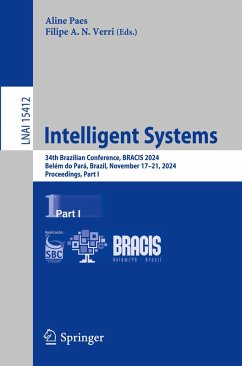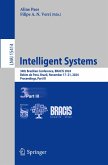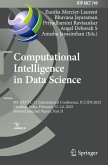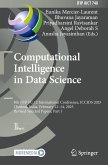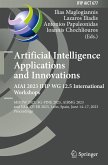Intelligent Systems
34th Brazilian Conference, BRACIS 2024, Belém do Pará, Brazil, November 17-21, 2024, Proceedings, Part I
Herausgegeben:Paes, Aline; Verri, Filipe A. N.
Intelligent Systems
34th Brazilian Conference, BRACIS 2024, Belém do Pará, Brazil, November 17-21, 2024, Proceedings, Part I
Herausgegeben:Paes, Aline; Verri, Filipe A. N.
- Broschiertes Buch
- Merkliste
- Auf die Merkliste
- Bewerten Bewerten
- Teilen
- Produkt teilen
- Produkterinnerung
- Produkterinnerung
The four-volume set LNAI 15412-15415 constitutes the refereed proceedings of the 34th Brazilian Conference on Intelligent Systems, BRACIS 2024, held in Belém do Pará, Brazil, during November 18-21, 2024.
The 116 full papers presented here were carefully reviewed and selected from 285 submissions. They were organized in three key tracks: 70 articles in the main track, showcasing cutting-edge AI methods and solid results; 10 articles in the AI for Social Good track, featuring innovative applications of AI for societal benefit using established methodologies; and 36 articles in other AI…mehr
Andere Kunden interessierten sich auch für
![Intelligent Systems Intelligent Systems]() Intelligent Systems44,99 €
Intelligent Systems44,99 €![Intelligent Systems Intelligent Systems]() Intelligent Systems56,99 €
Intelligent Systems56,99 €![Intelligent Systems Intelligent Systems]() Intelligent Systems56,99 €
Intelligent Systems56,99 €![Computational Intelligence in Data Science Computational Intelligence in Data Science]() Computational Intelligence in Data Science153,99 €
Computational Intelligence in Data Science153,99 €![Computational Intelligence in Data Science Computational Intelligence in Data Science]() Computational Intelligence in Data Science83,99 €
Computational Intelligence in Data Science83,99 €![Computational Intelligence in Data Science Computational Intelligence in Data Science]() Computational Intelligence in Data Science151,99 €
Computational Intelligence in Data Science151,99 €![Artificial Intelligence Applications and Innovations. AIAI 2023 IFIP WG 12.5 International Workshops Artificial Intelligence Applications and Innovations. AIAI 2023 IFIP WG 12.5 International Workshops]() Artificial Intelligence Applications and Innovations. AIAI 2023 IFIP WG 12.5 International Workshops91,99 €
Artificial Intelligence Applications and Innovations. AIAI 2023 IFIP WG 12.5 International Workshops91,99 €-
-
-
The four-volume set LNAI 15412-15415 constitutes the refereed proceedings of the 34th Brazilian Conference on Intelligent Systems, BRACIS 2024, held in Belém do Pará, Brazil, during November 18-21, 2024.
The 116 full papers presented here were carefully reviewed and selected from 285 submissions. They were organized in three key tracks: 70 articles in the main track, showcasing cutting-edge AI methods and solid results; 10 articles in the AI for Social Good track, featuring innovative applications of AI for societal benefit using established methodologies; and 36 articles in other AI applications, presenting novel applications using established AI methods, naturally considering the ethical aspects of the application.
The 116 full papers presented here were carefully reviewed and selected from 285 submissions. They were organized in three key tracks: 70 articles in the main track, showcasing cutting-edge AI methods and solid results; 10 articles in the AI for Social Good track, featuring innovative applications of AI for societal benefit using established methodologies; and 36 articles in other AI applications, presenting novel applications using established AI methods, naturally considering the ethical aspects of the application.
Produktdetails
- Produktdetails
- Lecture Notes in Computer Science 15412
- Verlag: Springer / Springer Nature Switzerland / Springer, Berlin
- Artikelnr. des Verlages: 978-3-031-79028-7
- Seitenzahl: 508
- Erscheinungstermin: Januar 2025
- Englisch
- Abmessung: 235mm x 155mm x 28mm
- Gewicht: 762g
- ISBN-13: 9783031790287
- ISBN-10: 3031790286
- Artikelnr.: 71981823
- Herstellerkennzeichnung
- Springer-Verlag KG
- Sachsenplatz 4-6
- 1201 Wien, AT
- ProductSafety@springernature.com
- Lecture Notes in Computer Science 15412
- Verlag: Springer / Springer Nature Switzerland / Springer, Berlin
- Artikelnr. des Verlages: 978-3-031-79028-7
- Seitenzahl: 508
- Erscheinungstermin: Januar 2025
- Englisch
- Abmessung: 235mm x 155mm x 28mm
- Gewicht: 762g
- ISBN-13: 9783031790287
- ISBN-10: 3031790286
- Artikelnr.: 71981823
- Herstellerkennzeichnung
- Springer-Verlag KG
- Sachsenplatz 4-6
- 1201 Wien, AT
- ProductSafety@springernature.com
.- Main Track.
.- A Contrastive Objective for Training Continuous Generative Flow Networks.
.- A Data Distribution-based Ensemble Generation Applied to Wind Speed Forecasting.
.- A Large Dataset of Spontaneous Speech with the Accent Spoken in Sao Paulo for Automatic Speech Recognition Evaluation.
.- A Multi-Level Semantics Formalism for Multi-Agent Microservices.
.- A Novel Genetic Algorithm Approach for Discriminative Subspace Optimization.
.- A Performance Increment Strategy for Semantic Segmentation of Low-Resolution Images from Damaged Roads.
.- A Unified Framework for Average Reward Criterion and Risk.
.- Adaptive Client-Dropping in Federated Learning: Preserving Data Integrity in Medical Domains.
.- An Ensemble of LLMs finetuned with LoRA for NER in Portuguese legal documents.
.- An instance level analysis of classification difficulty for unlabeled data.
.- Analyzing the Impact of Coarsening on k-Partite Network Classification.
.- Applying Transformers for Anomaly Detection in Bus Trajectories.
.- Aroeira: A Curated Corpus for the Portuguese Language with a Large Number of Tokens.
.- Assessing Adversarial Effects of Noise in Missing Data Imputation.
.- Assessing European and Brazilian Portuguese LLMs for NER in specialized domains.
.- BASWE: Balanced Accuracy-based Sliding Window Ensemble for Classification in Imbalanced Data Streams with Concept Drift.
.- Beyond Audio Signals: Generative Model-Based Speaker Diarization in Portuguese.
.- Classification of Non-Alcoholic Hepatic Steatosis in Liver Thermal Imaging Using Siamese Neural Network.
.- Classifying graphs of elementary mathematical functions using Convolutional Neural Networks.
.- Comparing Neural Network Encodings for Logic-based Explainability.
.- Deep learning approach to temporal dimensionality reduction of volumetric computed tomography.
.- Deployment of IBM Federated Learning Platform and Aggregation Algorithm Comparison: A Case Study Using the MNIST Dataset.
.- Detection of Pathological Regions of the Gastrointestinal Tract in Capsule Images Using EfficientNetV2 and YOLOv8.
.- Dual-Bandwidth Spectrogram Analysis for Speaker Verification.
.- Dynamicity Analysis in the Selection of Classifier Ensembles Parameters.
.- Embedding Representations for AutoML Pipelines.
.- Enhancing Graph Data Quality by Leveraging Heterogeneous Node Features and Embeddings.
.- Ensemble of CNNs for Enhanced Leukocyte Classification in Acute Myeloid Leukemia Diagnosis.
.- ERASMO: Leveraging Large Language Models for Enhanced Clustering Segmentation.
.- Euclidean Alignment for Transfer Learning in Multi-band Common Spatial Pattern.
.- Evaluating CNN-Based Classification Models Combined with the Smoothed Pseudo Wigner-Ville Distribution to Identify Low Probability of Interception Radar Signals.
.- Evaluating Large Language Models for Tax Law Reasoning.
.- Explaining Biomarker Response to Anticoagulant Therapy in Atrial Fibrillation: A Study of Warfarin and Rivaroxaban with Machine Learning Models.
.- A Contrastive Objective for Training Continuous Generative Flow Networks.
.- A Data Distribution-based Ensemble Generation Applied to Wind Speed Forecasting.
.- A Large Dataset of Spontaneous Speech with the Accent Spoken in Sao Paulo for Automatic Speech Recognition Evaluation.
.- A Multi-Level Semantics Formalism for Multi-Agent Microservices.
.- A Novel Genetic Algorithm Approach for Discriminative Subspace Optimization.
.- A Performance Increment Strategy for Semantic Segmentation of Low-Resolution Images from Damaged Roads.
.- A Unified Framework for Average Reward Criterion and Risk.
.- Adaptive Client-Dropping in Federated Learning: Preserving Data Integrity in Medical Domains.
.- An Ensemble of LLMs finetuned with LoRA for NER in Portuguese legal documents.
.- An instance level analysis of classification difficulty for unlabeled data.
.- Analyzing the Impact of Coarsening on k-Partite Network Classification.
.- Applying Transformers for Anomaly Detection in Bus Trajectories.
.- Aroeira: A Curated Corpus for the Portuguese Language with a Large Number of Tokens.
.- Assessing Adversarial Effects of Noise in Missing Data Imputation.
.- Assessing European and Brazilian Portuguese LLMs for NER in specialized domains.
.- BASWE: Balanced Accuracy-based Sliding Window Ensemble for Classification in Imbalanced Data Streams with Concept Drift.
.- Beyond Audio Signals: Generative Model-Based Speaker Diarization in Portuguese.
.- Classification of Non-Alcoholic Hepatic Steatosis in Liver Thermal Imaging Using Siamese Neural Network.
.- Classifying graphs of elementary mathematical functions using Convolutional Neural Networks.
.- Comparing Neural Network Encodings for Logic-based Explainability.
.- Deep learning approach to temporal dimensionality reduction of volumetric computed tomography.
.- Deployment of IBM Federated Learning Platform and Aggregation Algorithm Comparison: A Case Study Using the MNIST Dataset.
.- Detection of Pathological Regions of the Gastrointestinal Tract in Capsule Images Using EfficientNetV2 and YOLOv8.
.- Dual-Bandwidth Spectrogram Analysis for Speaker Verification.
.- Dynamicity Analysis in the Selection of Classifier Ensembles Parameters.
.- Embedding Representations for AutoML Pipelines.
.- Enhancing Graph Data Quality by Leveraging Heterogeneous Node Features and Embeddings.
.- Ensemble of CNNs for Enhanced Leukocyte Classification in Acute Myeloid Leukemia Diagnosis.
.- ERASMO: Leveraging Large Language Models for Enhanced Clustering Segmentation.
.- Euclidean Alignment for Transfer Learning in Multi-band Common Spatial Pattern.
.- Evaluating CNN-Based Classification Models Combined with the Smoothed Pseudo Wigner-Ville Distribution to Identify Low Probability of Interception Radar Signals.
.- Evaluating Large Language Models for Tax Law Reasoning.
.- Explaining Biomarker Response to Anticoagulant Therapy in Atrial Fibrillation: A Study of Warfarin and Rivaroxaban with Machine Learning Models.
.- Main Track.
.- A Contrastive Objective for Training Continuous Generative Flow Networks.
.- A Data Distribution-based Ensemble Generation Applied to Wind Speed Forecasting.
.- A Large Dataset of Spontaneous Speech with the Accent Spoken in Sao Paulo for Automatic Speech Recognition Evaluation.
.- A Multi-Level Semantics Formalism for Multi-Agent Microservices.
.- A Novel Genetic Algorithm Approach for Discriminative Subspace Optimization.
.- A Performance Increment Strategy for Semantic Segmentation of Low-Resolution Images from Damaged Roads.
.- A Unified Framework for Average Reward Criterion and Risk.
.- Adaptive Client-Dropping in Federated Learning: Preserving Data Integrity in Medical Domains.
.- An Ensemble of LLMs finetuned with LoRA for NER in Portuguese legal documents.
.- An instance level analysis of classification difficulty for unlabeled data.
.- Analyzing the Impact of Coarsening on k-Partite Network Classification.
.- Applying Transformers for Anomaly Detection in Bus Trajectories.
.- Aroeira: A Curated Corpus for the Portuguese Language with a Large Number of Tokens.
.- Assessing Adversarial Effects of Noise in Missing Data Imputation.
.- Assessing European and Brazilian Portuguese LLMs for NER in specialized domains.
.- BASWE: Balanced Accuracy-based Sliding Window Ensemble for Classification in Imbalanced Data Streams with Concept Drift.
.- Beyond Audio Signals: Generative Model-Based Speaker Diarization in Portuguese.
.- Classification of Non-Alcoholic Hepatic Steatosis in Liver Thermal Imaging Using Siamese Neural Network.
.- Classifying graphs of elementary mathematical functions using Convolutional Neural Networks.
.- Comparing Neural Network Encodings for Logic-based Explainability.
.- Deep learning approach to temporal dimensionality reduction of volumetric computed tomography.
.- Deployment of IBM Federated Learning Platform and Aggregation Algorithm Comparison: A Case Study Using the MNIST Dataset.
.- Detection of Pathological Regions of the Gastrointestinal Tract in Capsule Images Using EfficientNetV2 and YOLOv8.
.- Dual-Bandwidth Spectrogram Analysis for Speaker Verification.
.- Dynamicity Analysis in the Selection of Classifier Ensembles Parameters.
.- Embedding Representations for AutoML Pipelines.
.- Enhancing Graph Data Quality by Leveraging Heterogeneous Node Features and Embeddings.
.- Ensemble of CNNs for Enhanced Leukocyte Classification in Acute Myeloid Leukemia Diagnosis.
.- ERASMO: Leveraging Large Language Models for Enhanced Clustering Segmentation.
.- Euclidean Alignment for Transfer Learning in Multi-band Common Spatial Pattern.
.- Evaluating CNN-Based Classification Models Combined with the Smoothed Pseudo Wigner-Ville Distribution to Identify Low Probability of Interception Radar Signals.
.- Evaluating Large Language Models for Tax Law Reasoning.
.- Explaining Biomarker Response to Anticoagulant Therapy in Atrial Fibrillation: A Study of Warfarin and Rivaroxaban with Machine Learning Models.
.- A Contrastive Objective for Training Continuous Generative Flow Networks.
.- A Data Distribution-based Ensemble Generation Applied to Wind Speed Forecasting.
.- A Large Dataset of Spontaneous Speech with the Accent Spoken in Sao Paulo for Automatic Speech Recognition Evaluation.
.- A Multi-Level Semantics Formalism for Multi-Agent Microservices.
.- A Novel Genetic Algorithm Approach for Discriminative Subspace Optimization.
.- A Performance Increment Strategy for Semantic Segmentation of Low-Resolution Images from Damaged Roads.
.- A Unified Framework for Average Reward Criterion and Risk.
.- Adaptive Client-Dropping in Federated Learning: Preserving Data Integrity in Medical Domains.
.- An Ensemble of LLMs finetuned with LoRA for NER in Portuguese legal documents.
.- An instance level analysis of classification difficulty for unlabeled data.
.- Analyzing the Impact of Coarsening on k-Partite Network Classification.
.- Applying Transformers for Anomaly Detection in Bus Trajectories.
.- Aroeira: A Curated Corpus for the Portuguese Language with a Large Number of Tokens.
.- Assessing Adversarial Effects of Noise in Missing Data Imputation.
.- Assessing European and Brazilian Portuguese LLMs for NER in specialized domains.
.- BASWE: Balanced Accuracy-based Sliding Window Ensemble for Classification in Imbalanced Data Streams with Concept Drift.
.- Beyond Audio Signals: Generative Model-Based Speaker Diarization in Portuguese.
.- Classification of Non-Alcoholic Hepatic Steatosis in Liver Thermal Imaging Using Siamese Neural Network.
.- Classifying graphs of elementary mathematical functions using Convolutional Neural Networks.
.- Comparing Neural Network Encodings for Logic-based Explainability.
.- Deep learning approach to temporal dimensionality reduction of volumetric computed tomography.
.- Deployment of IBM Federated Learning Platform and Aggregation Algorithm Comparison: A Case Study Using the MNIST Dataset.
.- Detection of Pathological Regions of the Gastrointestinal Tract in Capsule Images Using EfficientNetV2 and YOLOv8.
.- Dual-Bandwidth Spectrogram Analysis for Speaker Verification.
.- Dynamicity Analysis in the Selection of Classifier Ensembles Parameters.
.- Embedding Representations for AutoML Pipelines.
.- Enhancing Graph Data Quality by Leveraging Heterogeneous Node Features and Embeddings.
.- Ensemble of CNNs for Enhanced Leukocyte Classification in Acute Myeloid Leukemia Diagnosis.
.- ERASMO: Leveraging Large Language Models for Enhanced Clustering Segmentation.
.- Euclidean Alignment for Transfer Learning in Multi-band Common Spatial Pattern.
.- Evaluating CNN-Based Classification Models Combined with the Smoothed Pseudo Wigner-Ville Distribution to Identify Low Probability of Interception Radar Signals.
.- Evaluating Large Language Models for Tax Law Reasoning.
.- Explaining Biomarker Response to Anticoagulant Therapy in Atrial Fibrillation: A Study of Warfarin and Rivaroxaban with Machine Learning Models.

